Key takeaways:
- Hydro energy production efficiently converts kinetic energy from flowing water into electricity, highlighting its potential for a sustainable future.
- While providing reliable energy, hydropower also supports flood control and irrigation, benefitting both communities and ecosystems.
- Innovations in hydropower technology, such as small modular systems and enhanced turbine designs, aim to improve efficiency and reduce environmental impacts.
- Collaboration with local communities and adaptive management practices are essential for developing sustainable hydropower solutions that meet both energy and ecological needs.
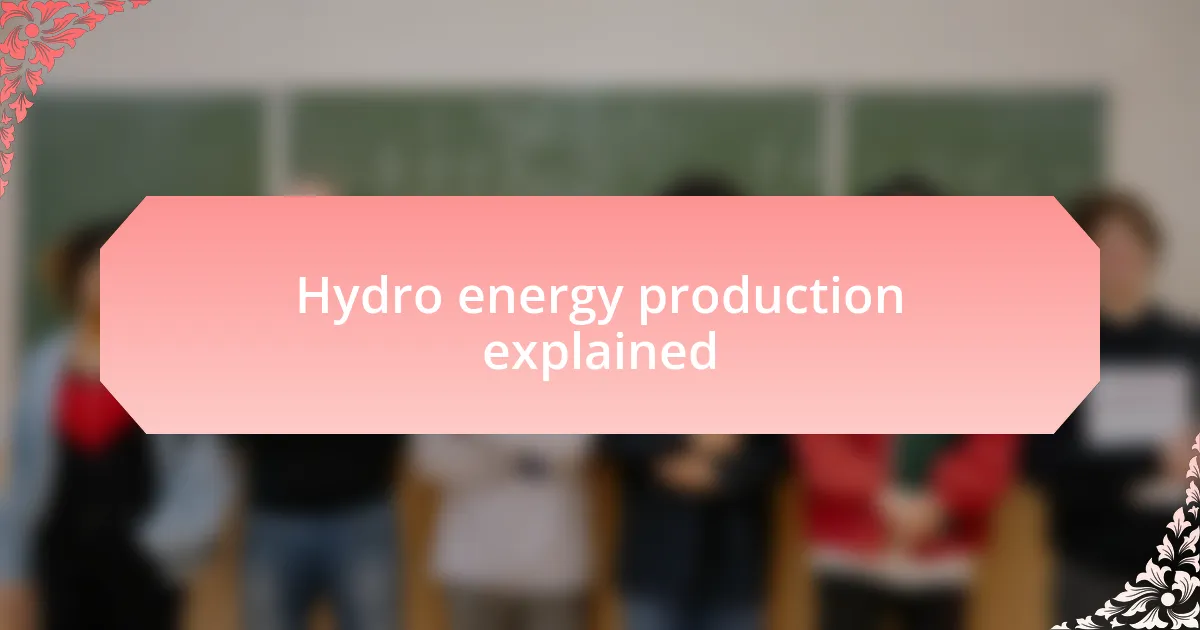
Hydro energy production explained
Hydro energy production harnesses the power of flowing water to generate electricity. I remember visiting a hydroelectric plant a few years ago; standing beside the massive turbines, I felt a mix of awe and curiosity. It struck me how the movement of water, whether from rivers or reservoirs, is transformed into electrical energy, illustrating nature’s raw strength and ingenuity.
At its core, hydro energy production relies on the water cycle. When water flows from higher elevations to lower ones, it creates kinetic energy. Have you ever thought about how the gentle flow of a river can generate such powerful electricity? It feels almost miraculous to me, as if nature itself is working to provide renewable energy while supporting ecosystems along the way.
The efficiency of hydroelectric systems is impressive; they can convert nearly 90% of the energy from water into usable electricity. This efficiency brings both excitement and responsibility. I often wonder how we can continue to innovate in this field to balance energy production with environmental stewardship. Embracing hydro energy could be a key part of our sustainable future, and it’s thrilling to think about what advancements lie ahead.
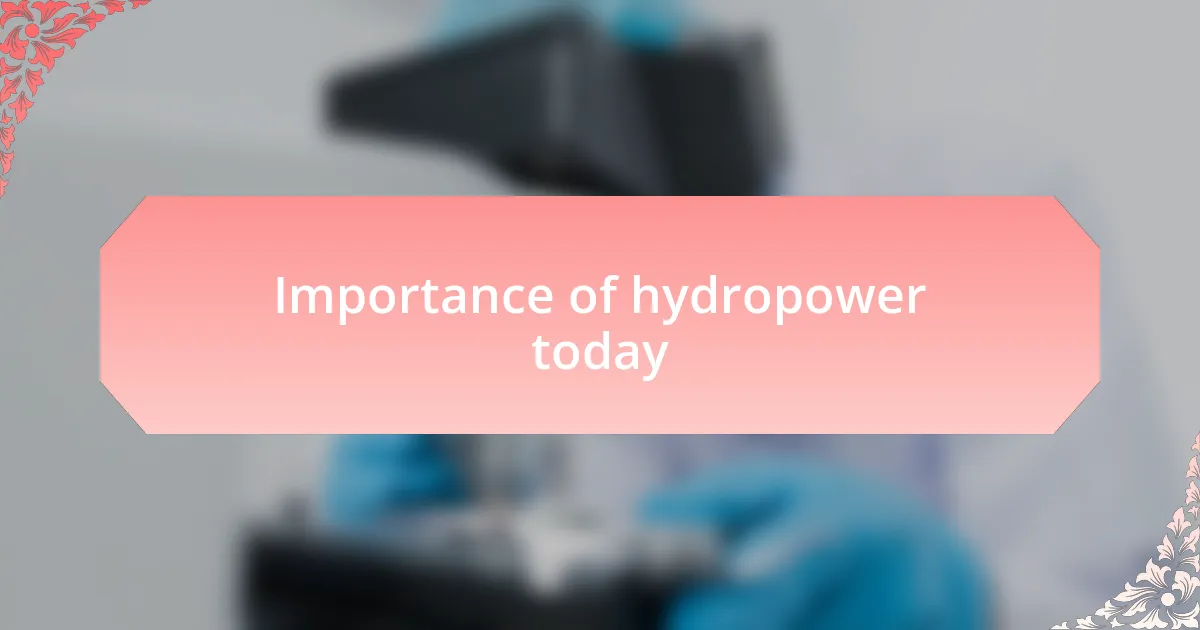
Importance of hydropower today
Hydropower serves as a cornerstone of our current energy landscape, providing about 16% of the world’s electricity. I remember reading a report that showcased how countries with a strong hydropower presence, like Norway, generate almost 100% of their electricity from this renewable source. It made me appreciate the potential of hydropower to not only meet our energy needs but to do so sustainably, reducing our reliance on fossil fuels.
In my view, the importance of hydropower today goes beyond just electricity generation; it also contributes to flood control and irrigation. I’ve seen how communities benefit from reservoirs that store water and regulate flow, ensuring that agriculture thrives even in drought. Isn’t it remarkable to think that while we’re harnessing energy, we’re simultaneously supporting food production and protecting lives?
Environmental impacts are always at the forefront of my mind when we discuss energy sources. I’ve witnessed debates around hydropower projects, weighing their advantages against potential ecological disruptions. This led me to wonder: how do we strike the right balance? As I delve deeper into these discussions, it becomes clear that hydropower remains vital not only for its efficiency but also for its role in promoting environmental resilience and climate adaptation.
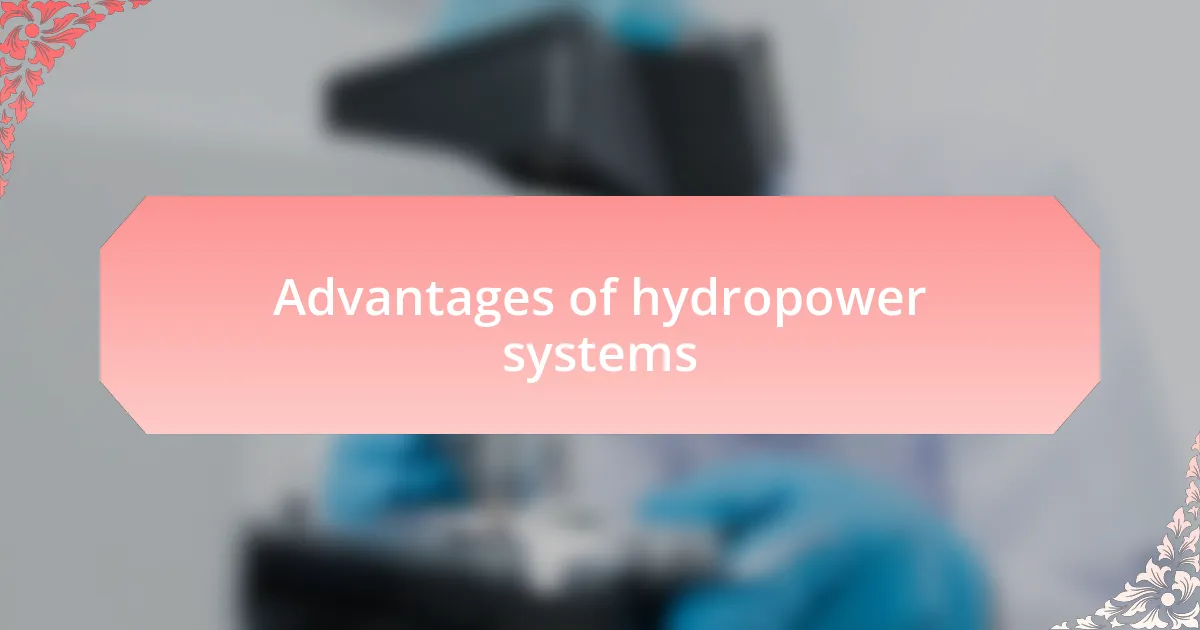
Advantages of hydropower systems
One of the standout advantages of hydropower systems is their reliability as a constant source of energy. I can recall visiting a hydropower plant and being amazed by how water could be harnessed consistently, unlike solar or wind energy which can fluctuate. This reliability means that communities can depend on hydropower for a steady electricity supply, ensuring that homes and businesses have power when they need it most.
Another significant benefit lies in the low operating costs once a hydropower facility is built. I’ve seen budget-conscious local governments invest in hydropower projects, realizing that while the initial investment can be substantial, the long-term maintenance costs are relatively low. It’s like planting a tree; it takes time to grow, but once it’s established, it can provide shade and fruit for years to come. This financial sustainability not only helps in keeping energy prices stable but also supports local economies.
Lastly, hydropower is instrumental in reducing greenhouse gas emissions. I’ve spoken to environmental advocates who passionately discuss how using water to generate power significantly cuts down carbon footprints. This aligns with the broader conversation about climate change, making hydropower not just an energy solution but a crucial player in protecting our planet for future generations. Isn’t it inspiring to think that while we generate power, we’re also taking meaningful steps towards a healthier environment?

Challenges in hydropower development
Developing hydropower comes with its share of challenges, primarily environmental impacts. I vividly remember a conversation I had with a local resident near a proposed dam site who expressed concerns over how such projects could disrupt local ecosystems. This is a valid point, as creating dams can alter river flows and harm aquatic habitats, raising questions about the balance between energy production and environmental preservation.
Another challenge lies in the socio-economic displacement of communities. I once met a family who had to relocate because their village was submerged for a new hydropower project. Hearing their story made me realize that while these projects can bring energy benefits, they can also create significant upheaval for those living nearby. How do we weigh the need for renewable energy against the social costs incurred?
Furthermore, financing such large-scale projects poses its own set of hurdles. I’ve seen numerous funding discussions where stakeholders grapple with the high upfront costs required to build hydropower infrastructure. It made me appreciate the importance of innovative funding models that can make these projects more feasible, ensuring that we can harness water resources effectively while addressing the economic realities that come with them.
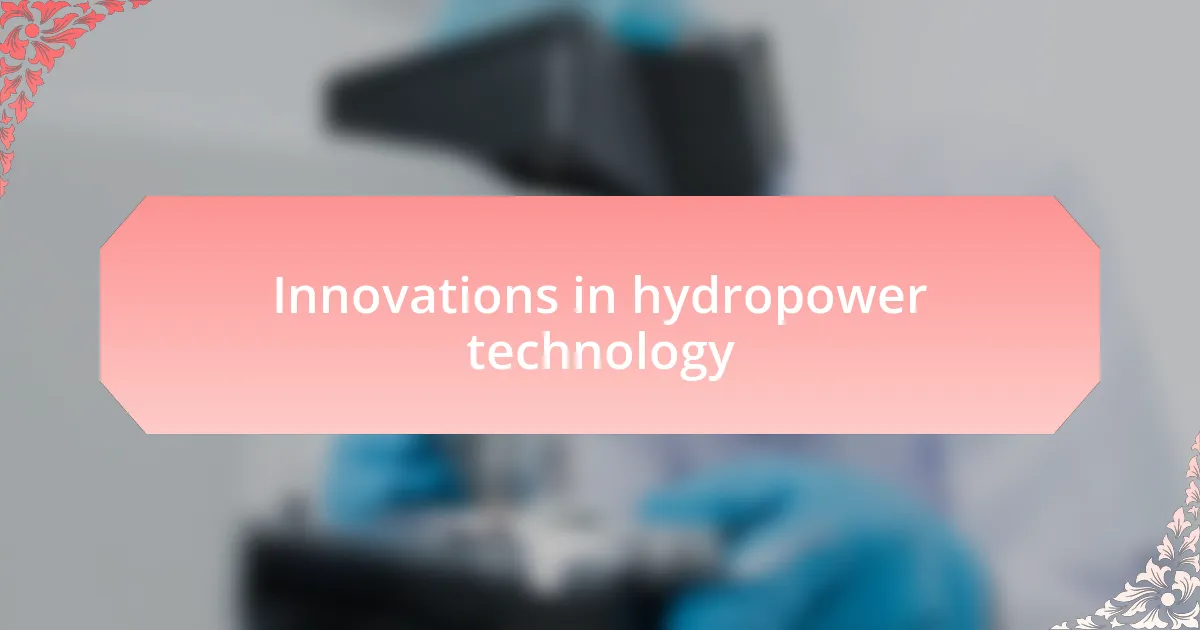
Innovations in hydropower technology
Innovations in hydropower technology are paving the way for more sustainable and efficient energy production. For instance, I recently came across a fascinating project involving small modular hydropower systems that can be installed in existing water infrastructure. It sparked my curiosity about how these mini-systems not only reduce the ecological footprint but also empower communities by providing localized energy solutions. Isn’t it inspiring to think that people can generate their own power without the need for extensive dams?
Another remarkable development is the integration of hydropower with other renewable energy sources. Picture this: while visiting a facility that combines solar panels with a hydropower plant, I witnessed how energy storage systems could capitalize on fluctuating water levels. It made me wonder how this synergistic approach could radically change our dependence on fossil fuels. The ability to balance energy generation in different conditions could significantly boost energy reliability.
Moreover, advancements in turbine design are at the forefront of hydropower innovation. I recall a conversation with an engineer who shared insights on how modern turbine technology increases efficiency by capturing more kinetic energy from water flows. This raises the question: how much untapped potential lies in our rivers and streams? As these technologies continue to evolve, we may unlock new ways to harness energy without compromising our environment or community well-being.
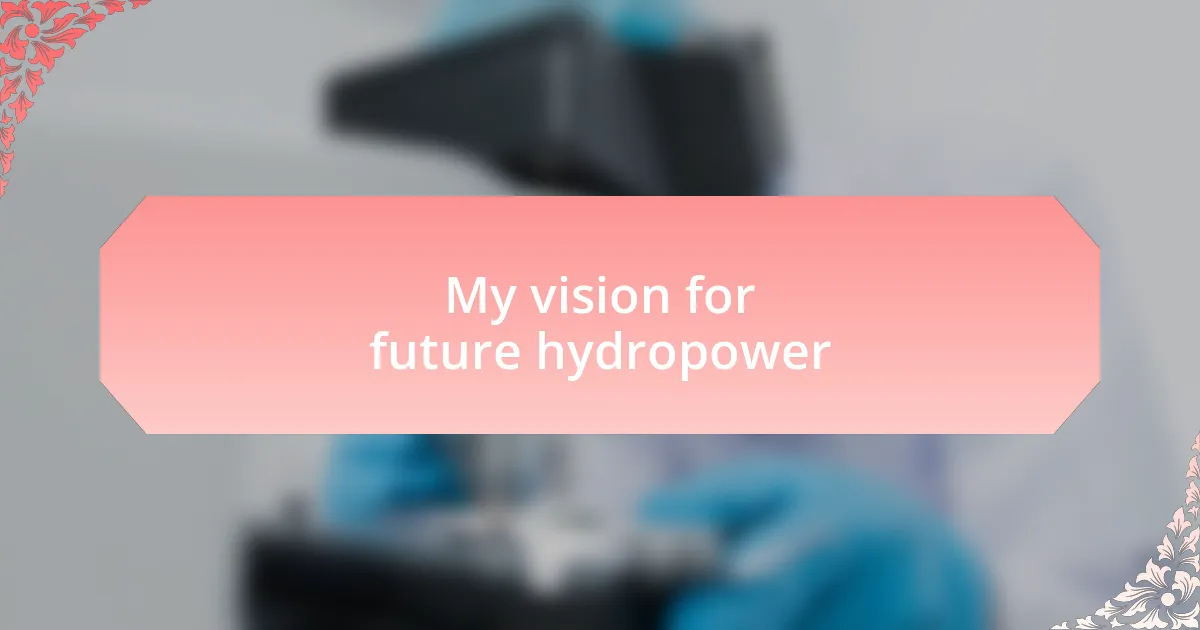
My vision for future hydropower
My vision for future hydropower centers on the idea of decentralization. I remember a trip to a remote village where I learned about a small-scale hydropower project that transformed the lives of the locals. Witnessing their newfound access to clean energy made me realize that localized systems could bring empowerment and independence to countless communities worldwide. Shouldn’t every village have the opportunity to thrive with renewable energy?
I also see great potential in the use of smart technologies within hydropower systems. A colleague of mine demonstrated how data analytics could optimize energy production by monitoring water levels and flow patterns in real-time. Imagine the possibilities if we could fine-tune operations dynamically to maximize efficiency and minimize environmental impacts. Doesn’t it excite you to think about the intersection of technology and sustainability in such a vital sector?
Looking ahead, I envision a future where aesthetics and functionality blend harmoniously. During a recent conference, I was struck by designs that integrated hydropower stations into urban landscapes as art installations. It made me dream of cities where energy production doesn’t detract from beauty but enhances it. Could it be that our urban environments will soon showcase the elegance of sustainable energy sources for everyone to appreciate?
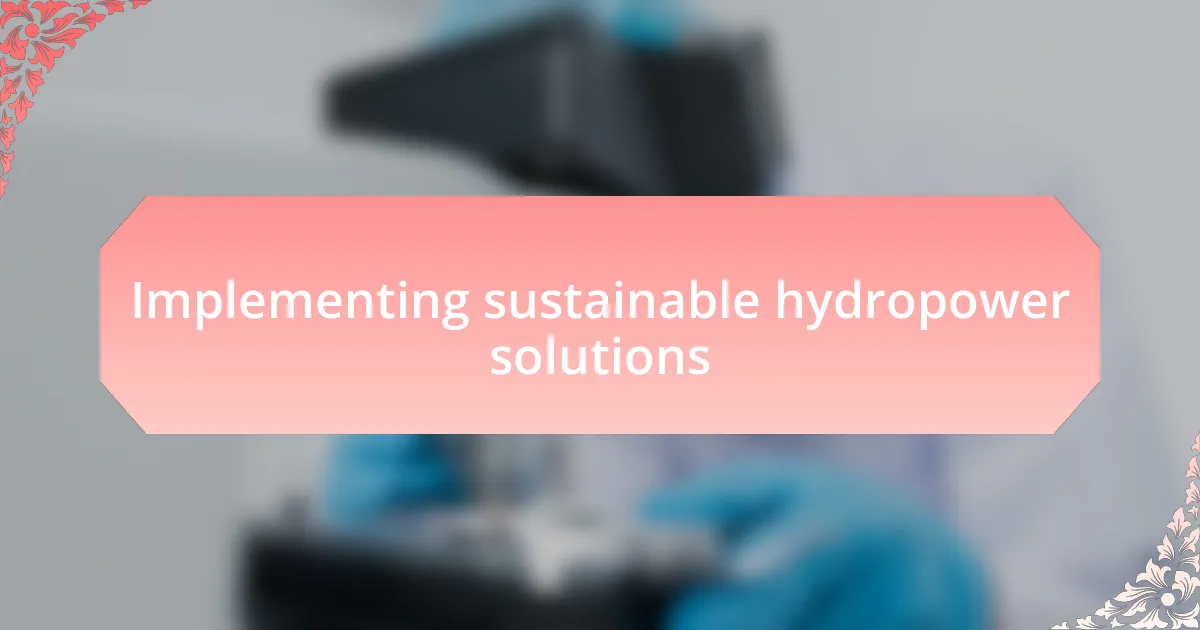
Implementing sustainable hydropower solutions
Implementing sustainable hydropower solutions requires a careful balance of ecological sensitivity and technological innovation. I recall visiting a site where engineers were piloting a fish-friendly turbine design. Watching how these turbines safely passed aquatic life while generating power left me hopeful—it’s a practical example of how we can enhance our energy infrastructure without compromising biodiversity. Isn’t it amazing how technology can bridge the gap between energy generation and environmental stewardship?
Collaboration with local communities is key to success in developing sustainable hydropower projects. In my experience working alongside local stakeholders, I’ve seen firsthand how engagement and input can shape outcomes that resonate with the community’s needs. When residents are part of the process, they feel a sense of ownership that leads to stronger, more sustainable practices. How often do we overlook the voice of the community in energy projects?
I’ve also found that adopting adaptive management practices can greatly enhance long-term sustainability. I once assisted a project that regularly evaluated its impact on local ecosystems, adjusting its operations based on those findings. This iterative approach not only ensures that we minimize negative consequences but also helps in building trust with stakeholders. Isn’t it crucial that we remain flexible and responsive as we integrate new knowledge into our hydropower solutions?